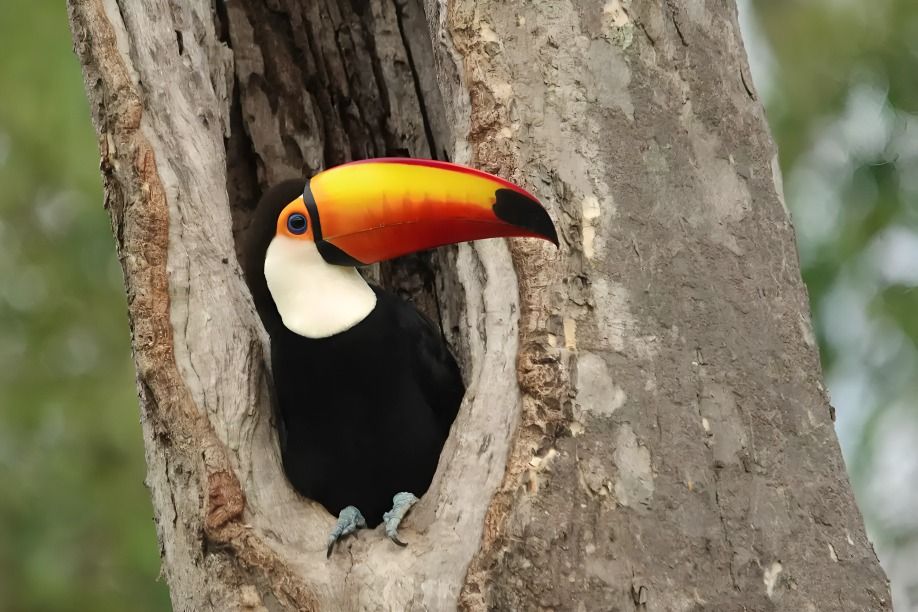
“
Toucans are among the most recognizable and fascinating birds in the world, known for their strikingly colorful beaks and vibrant plumage. These birds, native to the tropical forests of Central and South America, captivate anyone who catches a glimpse of them. The unique characteristics and behaviors of toucans make them a delightful subject of study, especially for young learners. In this blog, we will explore 20 Fascinating Toucan Facts that showcase their intriguing traits and essential role in their ecosystem. 1
1
1
”
Toucans eat insects, small reptiles, and bird eggs, contributing to their varied diet. This diverse nutrition helps maintain their health and energy, allowing them to thrive in their natural habitats and stay active. 1
Toucans have incredibly vibrant beaks. These beaks are made of keratin, the same material that makes up human hair and nails. Despite their large size, toucan beaks are surprisingly light and strong, perfect for their daily adventures. 2
The largest species of toucan, the toco toucan (Rhamphastos toco), grows up to 65 cm in length, with its huge bill making up a third of that length. Weighing up to 876 g, males are larger than females. It is native to eastern and central South America, especially Brazil. 3
Toucans have zygodactyl feet, with two toes facing forward and two facings backwards. This unique foot arrangement helps them balance perfectly and grip branches securely as they hop around the forest canopy. 4
Toucans are very social creatures and often live in small flocks. They enjoy playing games with each other, like passing fruit back and forth, which not only entertains them but also strengthens their social bonds. 5
They also enjoy insects, small reptiles, and bird eggs, ensuring they get a well-rounded diet that keeps them healthy and active. 6
Toucans are native to the lush tropical forests of Central and South America. They thrive in the dense canopies, where they find plenty of food, shelter, and safe spots to raise their young. 7

Instead of building nests like many other birds, toucans prefer to use natural cavities in trees. These cosy nooks provide a haven for their eggs and chicks, protecting them from predators and harsh weather.
Toucan chicks are born blind and without feathers, making them completely dependent on their parents. Over time, they grow stronger and develop their beautiful plumage, ready to explore the world outside their nest. 8
Toucans are not built for long-distance flying. They prefer to hop and glide from tree to tree, using their wings mainly for short bursts of flight to escape predators or move around their territory. 9
Each toucan species has its distinct call, ranging from croaks and toots to yelps and growls. These unique vocalizations help them communicate with each other in the dense, noisy forest environment. 10
Toucan beaks are not just for show; they also help regulate the bird’s body temperature. By adjusting blood flow to their beaks, toucans can release or retain heat, keeping themselves comfortable in the varying weather conditions of the rainforest. 11
Toucans have a special membrane over their eyes that acts like built-in goggles. This protective layer shields their eyes from dust and debris as they move swiftly through the forest canopy. 12

Toucans primarily eat fruit, making them frugivores. Their love for fruit plays a crucial role in their ecosystem, as they spread seeds through their droppings, helping new plants to grow and maintain the forest’s health.
Toucans typically have a lifespan of 15 to 20 years in the wild. In captivity, with proper care and a controlled environment, they can live up to 25 years. Their longevity is supported by a diet rich in fruits and occasional insects. 13
Toucans lay their eggs in tree cavities, with the female incubating them for about 16 to 20 days. Both parents share responsibilities, with the male bringing food to the female and chicks. After hatching, the chicks remain in the nest for several weeks. 14
There are about 40 different species of toucans, each with uniquely shaped and coloured beaks. These variations help scientists identify and study the diverse species and their adaptations to different environments. 15
Toucans play a crucial role in rainforest ecosystems by eating various native fruits. They pass seeds through their droppings, which promotes plant growth and helps sustain the forest’s biodiversity and health. 16
By spreading seeds and aiding in plant growth, toucans play a vital role in maintaining the health and diversity of their rainforest habitats. Their actions help preserve the delicate balance of the ecosystem. 17
A toucan’s long tongue, extending up to 5.9 inches, assists in foraging. This adaptation enables toucans to efficiently reach and consume a variety of fruits and insects, enhancing their ability to find and catch food effectively. 18


